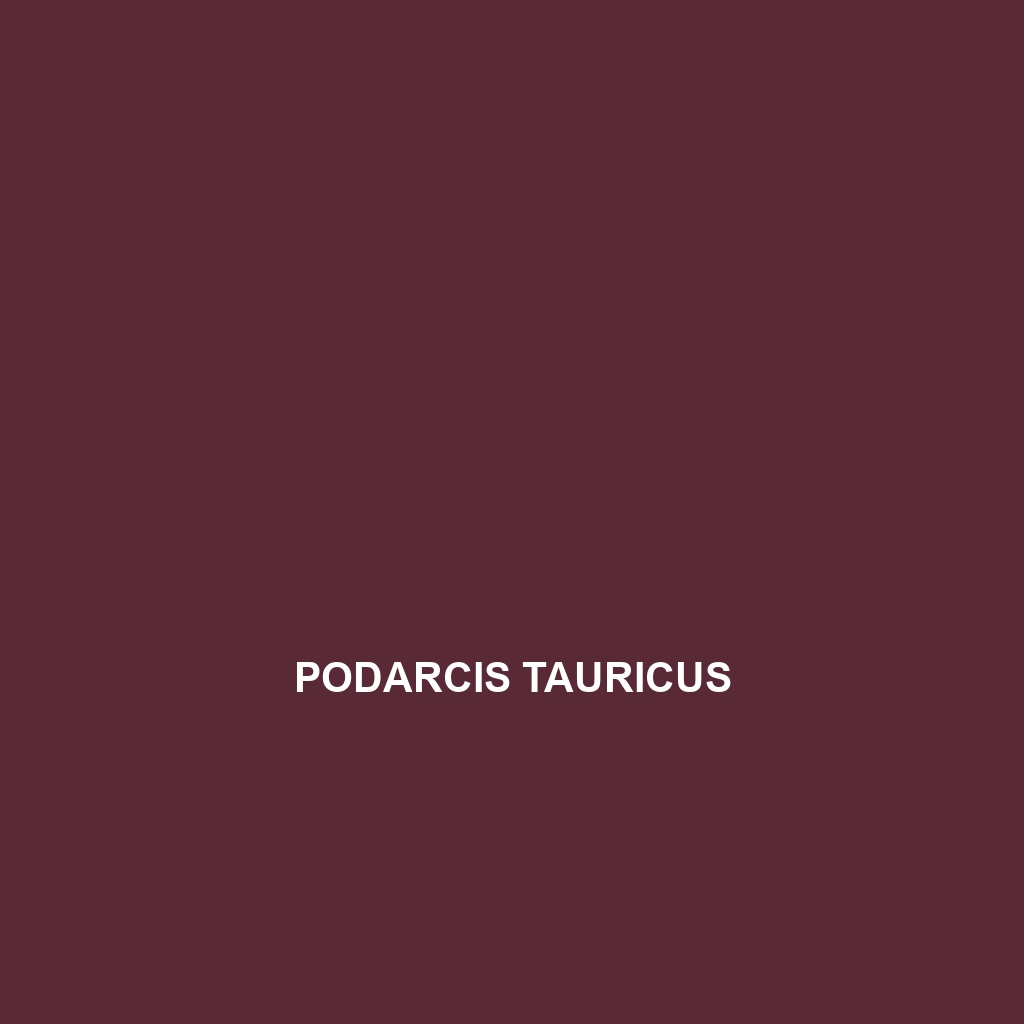Common Name
Podarcis tauricus
Scientific Name
Podarcis tauricus
Habitat
Podarcis tauricus, commonly known as the Turkish rock lizard, primarily inhabits regions across southeastern Europe and parts of western Asia. This species thrives in various habitats, including rocky outcrops, scrublands, and dry grasslands. The climate in these areas ranges from Mediterranean to temperate, providing warm summers and mild winters. They are adept at adapting to disturbed habitats as well, often found in rural areas, gardens, and even urban settings. The availability of sunlit rocks for basking and various crevices for refuge is crucial to their survival. These lizards are predominantly terrestrial, favoring environments that provide ample opportunities for foraging and shelter.
Physical Characteristics
Podarcis tauricus displays notable physical characteristics that make it easily identifiable. Typically, adults reach a size of about 20 to 25 cm in total length, including the tail. The body is elongated and slender, adapted for rapid movement across rocky terrains. Their coloration varies significantly, reflecting their habitat; individuals can be spotted in shades ranging from greenish to brown, often with dark marbling or spots along their dorsal side. This cryptic coloration aids in camouflage against predators. Unique features include a long, pointed snout and well-developed limbs that enable them to climb and navigate their environment effectively. Adults often exhibit a striking iridescence, especially when basking in sunlight, making them a beautiful sight for wildlife enthusiasts.
Behavior
Behaviorally, Podarcis tauricus is primarily diurnal, actively foraging for food during daylight hours. They display unique social interactions, often observed basking in groups on sunny rocks or engaging in territorial displays, particularly during the breeding season. Males often perform elaborate courtship displays, including push-ups and tail waving, to attract females. They exhibit local site fidelity, frequently returning to the same basking spots. Migration is typically not a characteristic of this species; instead, they demonstrate a sedentary lifestyle, with individuals establishing and defending specific home ranges. Additionally, they possess a remarkable ability to escape predators through rapid, agile movements and adept climbing skills.
Diet
Podarcis tauricus is an insectivore, feeding primarily on a diet of various invertebrates. Their diet consists of ants, beetles, grasshoppers, and other small arthropods, which provide them with the essential proteins required for growth and reproduction. While insects dominate their diet, they may also consume small fruits and plants, indicating some omnivorous tendencies. Their foraging behavior is strategic; they often hunt by ambushing their prey or actively searching among vegetation and rocky crevices. This adaptability allows them to thrive in environments where food sources can fluctuate seasonally.
Reproduction
The reproductive cycle of Podarcis tauricus is characterized by a distinct mating season during the spring months when temperatures begin to rise. Male lizards engage in courtship displays, attracting females for mating. After successful mating, females undergo a gestation period lasting approximately 4 to 8 weeks, depending on environmental conditions. Unlike some reptiles, Podarcis tauricus is oviparous, laying clutches of around 2 to 8 eggs within sandy or moist soil, where they are protected from predation. The eggs hatch in late summer, with young lizards emerging fully independent. This reproductive strategy enhances survival rates by synchronizing hatching with favorable conditions for growth and development.
Conservation Status
Podarcis tauricus is currently classified as of “Least Concern” according to the IUCN Red List. However, various factors threaten its habitat, including urbanization, agricultural expansion, and climate change. Although the species is relatively widespread in its natural range, local populations may decline due to habitat fragmentation and loss. Conservation efforts are ongoing to monitor populations and protect their natural habitats from degradation. Engaging local communities in conservation initiatives and raising awareness can further enhance the survival rates of this fascinating species.
Interesting Facts
One intriguing aspect of Podarcis tauricus is its remarkable adaptability to urban environments. These lizards have shown a capacity for surviving in man-made structures, utilizing gardens and parks as habitats. Additionally, they possess a unique ability to regenerate their tails after losing them as a defense mechanism, an adaptation common among many lizard species. This regenerative skill not only aids in evading predators but also contributes to their overall resilience in changing environments. Moreover, they play an essential role in local ecosystems by controlling insect populations and contributing to the food web.
Role in Ecosystem
Podarcis tauricus serves several vital roles in its ecosystem. As a predator of various insects, it helps regulate insect populations, contributing to the ecological balance. Through their feeding habits, they also assist in seed dispersal, indirectly promoting plant diversity. Additionally, they act as prey for larger predators, including birds and mammals, thus underscoring their importance in the food web. Continuously studying their ecological interactions can provide insights into the health of their habitats and the broader environment, showcasing their significance as a species within their ecosystem.
